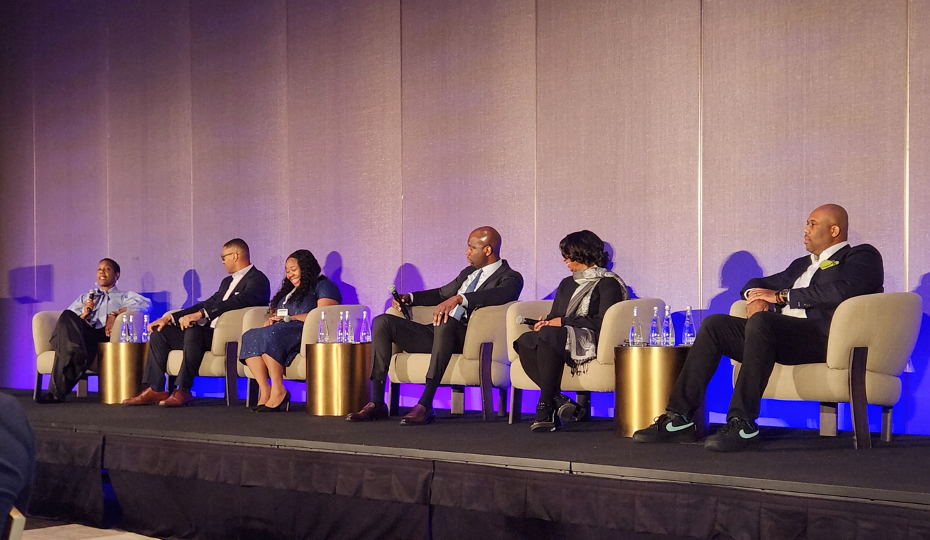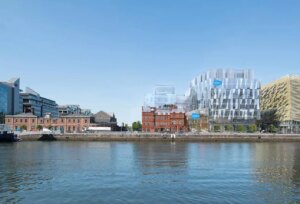It’s no secret that major coastal cities are grappling with corporate relocations and downsizings, workers resisting returning to the office full-time, anemic day-time business activity, and persistent crime and homelessness. Los Angeles is no exception. America’s second largest city is at a precipice, with new mayor Karen Bass at the helm. Tasked with tackling issues like homelessness and high vacancies in a beleaguered downtown, the mayor has her hands full. But on the other end of the spectrum, once overlooked communities are now experiencing unprecedented growth, creating new opportunities for economic prosperity. What does the future have in store for the city of angels? A group of LA’s most prominent real estate experts weighed in at the REEC 2023 Spring Conference.
Kimberly Brown, panel moderator and President of industry association AAREP LA (African American Real Estate Professionals) opened the conversation reminding the audience that the mayor’s success would largely hinge on the support she received from real estate organizations like AAREP and REEC.
“She needs our organization behind her. Her words. And we said, “say less.” We understand what that means. What that means is that this is a city, like many cities, with a host of challenges. There are some things…aging infrastructure, an affordable housing crisis. The thing that makes the second largest city unique is we kind of have everyone’s homeless here. That thread of homelessness is at the top of this mayor’s agenda, which makes this intersection with CRE so important in this moment.”
JLL’s James Malone elaborated on some of the issues facing downtown. “Downtown Los Angeles is having a rough time. There are 150 vacant full floors, concessions are $17-$20 PSF a year on the deal, rates have stayed relatively stable, but everyone is shrinking so pain is coming. If we are 20-25% vacant now, it’s going to get worse. The perception of downtown being overrun with homelessness and crime everywhere is not the reality, but you can’t ignore the perception. Any given day you can see some things where you scratch your head and say, “this is bad.” So, the issues the mayor needs to tackle to get people at least perceptibly downtown is going to be a big thing.”
Malone pointed out, however, that positive area demand should not be overlooked. “If you push all the office product to the side, and you focus on multifamily, it’s still over 90% leased, restaurants are open again, they’re crowded, people are going to Crypto, concerts, so the livelihood is back. It’s just that Monday-Friday 9-5 you could shoot a canon down Figueroa and not hit anybody. We have a problem getting people back in the office. What we’ve also seen is the FIRE (financial, insurance, real estate, legal) tenants are shrinking their footprint downtown and coming to places like Century City, which as comparison, is on fire.”
As to what it would take to draw back tenants, Malone offered a live case study, the U.S. Bank Tower, owned by Silverstein Properties. “I think what we are seeing is the amenities race. Landlords are trying to build tenant conference centers with a more hospitality feel. Silverstein did a great job with their lobby. It’s an office building lobby with wood and greenery, it’s not marble it’s not sterile. They have jazz music pumping there and places to come sit down and plug in. They built a tenant only amenity on a transfer floor with the same look and feel. It looks like the One Hotel.”
Ms. Brown pivoted the conversation to urban renewal, and what had gone from muted to heightened interest in once overlooked areas like South Central LA. “I’m a proud product of that community, one rich with culture, pride, history, and promise. What we’ll say overarching is that South LA has been historically overlooked. Even for the big brokerage firms there was a big swathe that was not even tracked because no one was checking for it. Nevertheless, the community is changing, and there is thought, concern, excitement and a surge in investment.”
Langdon Park’s Malcolm Johnson explained why. “Where our office sits was the northern most edge of South Central 20 years ago. Now it’s just South LA. I stopped in the office on West Adams, drove over and passed through west LA neighborhoods, Beverywood, Beverly Hills, and Century City and it took all of 15 minutes. Surface streets, 15-minute commute from the northern most part of South LA to get to the west side. That’s why there is so much interest in what was an overlooked, primarily black, now primarily Latino, part of our city.”
But Johnson went on to explain that to truly facilitate economic transformation of historically underserved areas, the change agents involved must have a deep understanding of its challenges and desires of its constituents. “Up until 2020 I was an employee at JP Morgan, and I always thought about how I could be more intentional about investing in communities like South LA, Southeast DC, East Bay up in Oakland, but have a scalable business. And is it turned out the world kind of woke up to we need to think about impact alongside real returns, so I launched Langdon Park Capital. But our first LP was a publicly traded firm based in Beverly Hills, $4.5 billion market cap, they have close to 44,000 apartment units in three continents and they said the only way we can go realize value in the types of communities you talk about is if we invest in a partner like you. The thesis should always say if you are talking about South LA, Washington DC, Harlem, South Side of Chicago, and you want institutional returns, you have to have an operator that is culturally competent and understands those communities.”
UDC’s Sherri Franklin made the point that all too often, professionals of color working with and for large institutions pour their expertise into creating successful projects that don’t impact their own communities. Her words offered optimism that more of those talents could and would be deployed into these transitioning areas. “So much of our energy goes into working with institutional firms and helping other people imagine and re-imagine what their assets can look like, what their communities can look like and by being intentional we can bring that energy back to our communities and vision, decide where is the value add and how we create the value add. People want to be involved in what we’ve got, culturally, and how engaging we create environments. I’d love to see us work to put plans in place saying this is our community. You are not going to brand it or name it.”
Ms. Franklin shared a real-life story to bring the point home. “Years ago, where Malcolm is talking about (a Langdon Park owned multifamily), it was where (the movie) Training Day was filmed. So just imagine it from Training Day to today, but before that it was a wealthy area for Jewish people in our community. It was called “The Jungle” because it was so lush, but then someone re-branded it to make jungle mean something different. And we got Training Day. I’m sure it was nice for the person who won the Academy Award, but it wasn’t for our community. And today we have leadership saying this is quality housing and we built it and make it for people from all income levels. We can decide that this is an important part of our neighborhood and not throw it away. And we can step up and lead in doing that.”
Like Ms. Brown, Ms. Franklin also emphasized the importance of leveraging affinity groups to help shape local legislation, such as the recently passed “Mansion Tax,” which adds a 5% tax on all assets over $5 million. The funds are earmarked for housing and various social services in communities of need. She explained, “Billions of dollars will flow down. There was a table in a room that the City of Los Angeles put together that looked the size of this conference, and they had people sitting around deciding how those dollars will be distributed. There were not many people who looked like us in that room. It’s important that we come together as a group and have our fingerprint on how it is going to be re-distributed. If it’s going to be for and about communities and people in need, then it should be people who understand it and who are of those communities that make decisions on those dollars.”
While the panelists seemed universally pleased to see once underserved communities attract new attention, the irony of it was lost on no one. Broker James Daughrity explained that for many minorities, these were the only areas they could cut their teeth professionally for years, because other brokers did not see merit in investing their time there. “When I first moved to LA a little over a decade ago, I interviewed a lot of different brokerage firms out here. None of them would hire me. This little boutique firm in LA said we will take a chance on you. And they told me our black guy just left, so we need someone like you. I said Oh! So, when I first started, me coming from the South Side of Chicago I said I want to sell properties in Beverly Hills and Santa Monica and we all know that people working at the big firms are very strategic on where they place you and you don’t have a say so. They’ll say, James you would be perfect for the South LA and Englewood submarket. So that’s where they put me.”
The experience turned out to be a blessing in disguise. Daughrity established relationships with local mom and pop businesses in Englewood, covering everything from retail to land and apartment sales, since there were so few brokers in the area. His patience paid dividends years later, as he now runs the largest independent brokerage in the area. “With the NFL stadium, the forum for more concerts, the Clipper stadium, Hollywood Park, which is bringing about 3,000 apartment units, this is all on one street less than a quarter of a mile. The entire city of Englewood is looking entirely different right now and it’s really changing the whole landscape. So before, when I could sell some land for about $80 per foot for the dirt, now that same dirt is going for $400-$500 per foot unentitled.”
Amazon’s London Kemp Boykin asserted that corporations have a unique opportunity to play a special role in the transformation of such communities.
“When you talk about being intentional, I think that needs to happen on the corporate side as well. Where you see the transportation-oriented district taking place right outside Crenshaw Baldwin Hills, it makes it possible to open the landscape to more corporates. 2018, when CIM had dropped out (of the acquisition), I was talking to (former employer) Netflix saying this could be the Silicon South, a space for production where you have more jobs and can invest outside of more traditional areas. And it was kind of a non-starter. Will talent go there? What would happen? Now you are seeing a resurgence of those conversations happen as a result of “Oh we have Sofi, we have Intuit, we also have the Olympics and World Cup coming we don’t want to miss out. My hope is that by being intentional and having partnerships across tenants, development, affordable housing, etc. you are able to do more, faster.”
For Johnson, the impact minorities ultimately make in Los Angeles and other cities like it will be linked to the availability of institutional capital. He observed, “On the screen earlier, it said with REEC alone there have been $2.1 billion dollars of brokerage and advisory transactions and $1.2 billion worth of debt and equity financing. My guess is that’s mostly debt and $2 millions worth of LP commitments. We can’t allow majority owned firms to take up $2.1 billion worth of fee business and give us $2 million in LP business. That’s hustling backwards. When the market shifts, we have to be prepared to go to the same groups that are more than happy to provide us with all kind of services, and say I’m bringing you a good deal and we expect you to be an LP and partner.”
While the next chapter of Los Angeles’ evolution is still being defined, it’s clear that minority professionals are both positioned and committed to playing a meaningful role in the transformation of the city in general and communities it holds most dear specifically.
Written by Vernon Beckford at [email protected]



